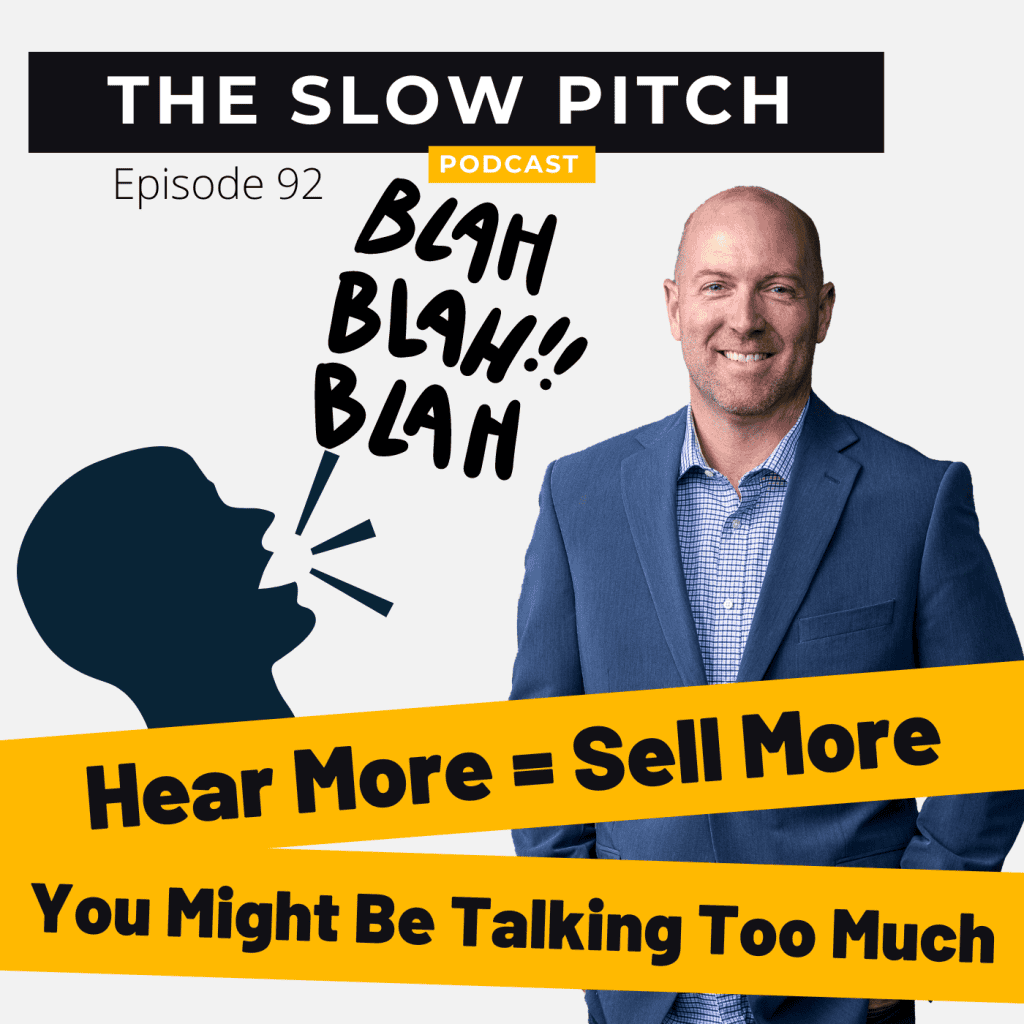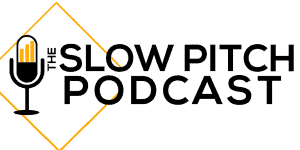Hear More (Talk Less), Sell More


Notes
In this episode of The Slow Pitch Podcast, Rob explores a critical yet frequently overlooked element of sales success: the need to talk less and listen more (listen and hear more of what they say to sell more). This episode tackles an important question for every sales professional: Are you talking too much? Using a compelling real-world story involving his friend Frank, Rob demonstrates why mastering the art of listening is crucial for achieving sales excellence.
Hear More – Balancing the Sales Dialogue
The episode begins with Rob challenging the common belief that a 50/50 split between talking and listening is ideal in sales interactions. He argues, “In an effective sales conversation, how much should you really be talking? Ideally, most of the talking should be done by the potential buyer.” This provocative stance sets the tone for a deeper discussion on the dynamics of effective communication in sales.
A Case of Excessive Talk
Rob recounts a lunch meeting with his friend Frank, which turns into a practical lesson on the pitfalls of dominating conversations. Frank shares his frustration over a sales meeting that went awry, pointing out his tendency to talk over his client. Rob draws a powerful analogy, comparing a salesperson offering unsolicited solutions to a waiter dictating a customer’s meal: “Imagine how you would feel if the server ordered for you without asking. That’s the same feeling your client gets when you overpower their needs with your talk.”
Insights from a Listener’s Perspective
Rob highlights a key moment from their discussion, noting Frank’s self-awareness as he admits, “I realized I said ‘I told her’ about six times in just two minutes. I needed to just listen.” This revelation emphasizes the episode’s main message—that salespeople often overlook essential information because they are too preoccupied with their own agendas.
Effective Strategies for Sales Conversations
Rob offers practical advice to improve sales interactions:
- Monitor Your Speaking Time: Be aware of how much you are speaking. Aim to let the client speak the majority of the time. Rob says, “If their lips are moving, you’re doing it wrong.”
- Ask Insightful Questions: Transition from offering premature solutions to uncovering the client’s explicit and implicit needs through thoughtful questions. The more questions you ask, the more they talk. The more they talk, the more you learn. The more you learn, the more you sell.
- Engage in Active Listening: Demonstrate genuine interest and understanding in what the client says, which in turn encourages them to share more openly.
Concluding Thoughts and What’s Next
Rob concludes the episode by stressing the importance of giving clients the space to express themselves. He leaves his audience with a reflective thought: “If their lips aren’t moving, you’re probably talking too much. Ask more questions and delve deeper into their needs.”
Anticipating the next episode, Rob hints at a discussion titled “Turning Listening Into Actionable Insights,” inviting listeners to discover more advanced techniques for converting listening into tangible sales results.
Keywords: Hear More In Sales, Talking Less in Sales, Sell More Through Listening
Related Content:
5 Tips For Salespeople (pt 4) Pain Questions
Sell More by Listening To Your Clients
Podcast Recorded on Squadcast.fm
NOTE: Some links may be affiliate links, which means we get paid a commission when you purchase, but it the cost remains the same for you.
Music: "Clydesdale Funk" by Cast of Characters, written by: Dustin Ransom.
The Episode
Rob 00:07
Welcome back, everybody. So The Slow Pitch, and today we’re going to talk about well talking, and how much you’re talking. Are you talking too much? There’s one way to find out if you’re talking too much, and that is to actually look at how much you’re actually talking. All right, I might be talking too much.
V/O 00:23
You’re listening to The Slow Pitch Podcast, a podcast about selling less and closing more.
Rob 00:30
All right, so today, we’re talking about you talking too much. Now, I know not everybody talks too much. I know that I sometimes feel like I’m talking too much. I don’t do a podcast. So you know, I, I just talk too much on this right, sometimes. Here’s the thing, knowing when to talk too much. And when not to talk too much is key. So if you had to guess how much of the time, 0% to 100% of the time, how much of the time should you actually be talking?
Rob 00:59
When you’re meeting with a potential client? What’s the appropriate amount of time, I’d love to hear your guests. So some people will answer 50/50. And I say that is incorrect. I believe that if you’re doing things correctly, most of the talking, if not almost all the talking is done by the potential buyer.
Rob 01:17
So I feel like the good number to keep try to keep yourself out is about 20% of the time. And an easy way to make sure that you’re not doing that is look at the person when you’re talking to them. And if their lips are moving, then you’re doing it right. That’s, that’s as simple as it is. Like, it shouldn’t be that difficult.
Rob 01:32
Here’s what I’m trying to get to. I had a conversation with a friend of mine, his name is Frank. Frank and I sat down at a restaurant, we had a reservation, we sat down, and it was in the unit. So he’s like, Hey, do you want a beer? Okay, fine. So we grabbed beers.
Rob 01:44
We’re sitting there talking, and he’s he’s frustrated about the sales meeting that he had. And that meeting went kind of sideways on him. He wasn’t doing things the right way. We hadn’t spoken before, and about this issue. And so all of a sudden, it was like I started listening to him.
Rob 02:01
Here’s what I heard, there was a point where he was saying to me, so in our sales meeting, we were they told me about this problem. And they, and I don’t want to get into the details of that type of problem, because I don’t want to give away his client who that was.
Rob 02:15
But he was like, we were talking about their problems… “And I told her that she should be doing this.” And then later, I told her, and then I told her, and one point I counted in my head while he was talking, literally four to six times, he said, I told her, and I said in about two minutes time, and I had to I just listened.
Rob 02:36
And this is over the course of 10 minutes. But at one point, he start to get really a lot. And so I stopped, listened and listen some more. And then when he finally stopped talking, which was fine, he needed to talk about all the different avenues and I was, as I was interested in, I was listening.
Rob 02:50
But when he finally did stop, I asked him a question. And here’s what I said to him. I go, you know, the server is going to come over here and ask us what we want to eat. How would you feel if the server came up to our table and said, Hey, Rob, how you doing? What do you what would you like for dinner tonight, and I tell the server, this is what I would like and the server says, okay, writes it down.
Rob 03:09
Then looks at you and says, and you know what Frank, you’re gonna have, you’re gonna have a steak, and you’re gonna have a side of mashed potatoes, and you’re gonna have green beans, and we’re gonna get you a glass of wine. And he goes, Why would they do that? And they go, well, because this is what you need. They said, This is what you need.
Rob 03:24
You look, you look like you haven’t you haven’t eaten in a while. So you need some more food. And you know what the beer is not good for you should have wine. That’s what it looks like.
Rob 03:30
And he goes, What do you mean, and I go, I’m just listening to your conversation that you just had about this potential client that you met with. And you told that person all the things that they needed, unsolicited, unsolicited, they were telling you what they needed, and you kind of listened.
Rob 03:46
But then you added more stuff that they that you thought that they needed. And it was very difficult for me to listen to that because I feel like you haven’t gotten let me ask you this. And I asked her, What is her pain? Number one, what is your pain? Number two, what is your pain? Number three? And he was like, I don’t know? I don’t know, I don’t know.
Rob 04:00
I’m like, how do you have a conversation and not know what her problem is that you’re trying to solve? You have a solution. And you have a lot of different ways to getting there. And it’s things you can solve. There’s a lot of things you can solve in their business.
Rob 04:11
You have not asked the question to find out which one is the priority? How much is it costing her? How much is it costing her personally? And how much is it going to affect her business? If she doesn’t affect it doesn’t affect fix that? And by doing those questions, you would know that the thing that you think is her problem, she does not think that and we don’t even know how do you know that?
Rob 04:33
And he was a little bit surprised by that. But the light bulb I saw went on. He’s like, I don’t know what to do. Now, what do I do? And I said, No, no, you’re fine. Don’t worry about it. We all mess this up. That’s okay.
Rob 04:43
Here’s what I would do. I would go and have a call phone call with her. See if she has a few minutes and just started out with this way. You know, I am so sorry. I messed up. We had a conversation yesterday or the other day, whatever it was. We had a conversation and I forgot to ask you a few questions and they’re kind of medical questions.
Rob 05:00
So I think I if you have like 15 minutes or so that I can at least ask these follow up questions. I would love to be able to do that. He called me the next day and told me the things that he thought were the problems are no longer the problems, it was something else.
Rob 05:12
So I said, What did you learn? He goes, I learned I didn’t have the sale. And I I’m not glad I learned that because I would have spent a lot of time wasting time on that.
Rob 05:19
The key point is if their mouth is not moving, you’re doing something wrong. Take a minute, pay attention to your next meeting. If their lips are not moving, you’re doing it wrong, ask more questions, and dig into that pain, you’ll start to find out some answers. I hope this helps if it helped you.
Rob 05:36
And if you somebody else who might be in this situation, share this episode with them, because they may be sitting there talking way too much. And it may be time for them to stop, ask a question and let them answer. Until next time, slow down and close more.
V/O 05:49
Thank you for listening to The Slow Pitch. Do you have a question about sales? Call or text your question at (608) 708- SLOW. That’s (608) 708-7569. Or you can email them to Questions@TheSlowPitch.com. Slow Down and Close More.
Rob 06:39
Thanks as always, for listening today. If you’d like this podcast, please subscribe and leave us a review. We really appreciate it. Follow us on Twitter, Instagram and Facebook at The Slow Pitch. We were mixed today as always by Johnny Polakis and we were produced by High Gravity Studios. Music credits and other notes are in the show notes section on TheSlowPitch.com and we’ll be back with another episode soon.








